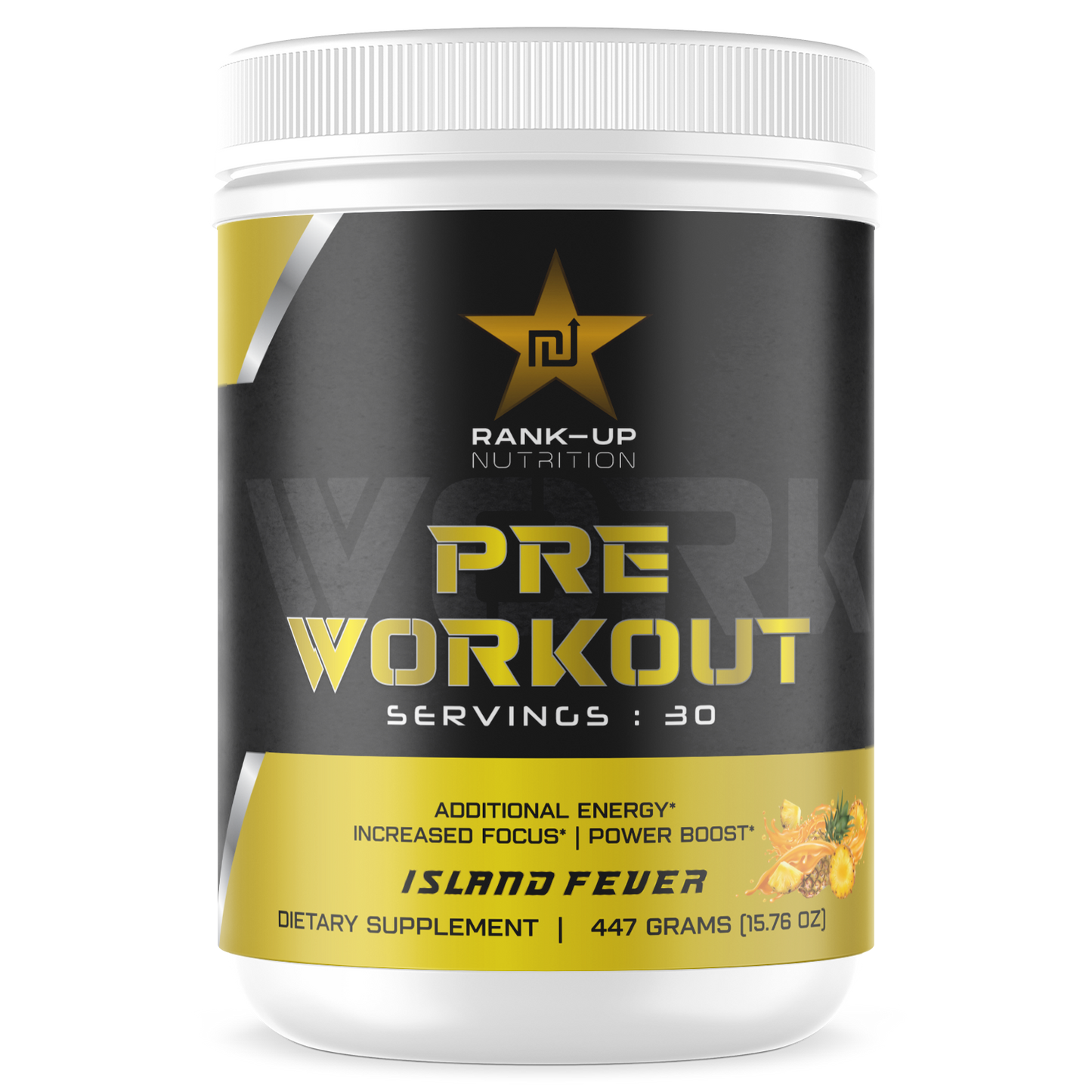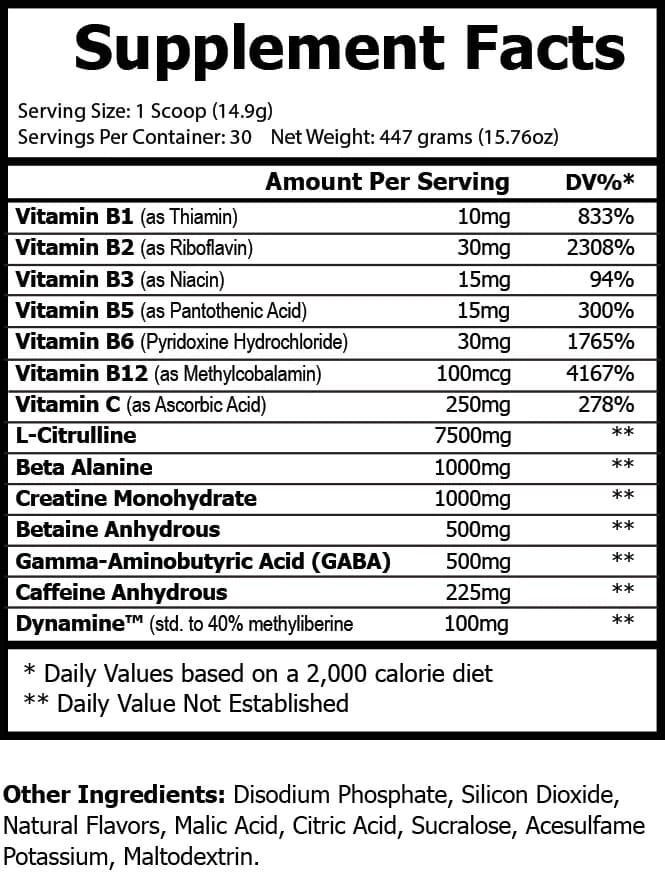Sports Nutrition
PRE-WORKOUT Explosion - Island Fever
PRE-WORKOUT Explosion - Island Fever
Couldn't load pickup availability
Used as a pre-workout supplement to promote energy, increase focus and maintain endurance. It encourages the mind and body to respond quickly during a workout and allows more nutrition to flow through the body to your muscles. This pre-workout will not cause sleep disturbances when taken close to the end of the day. It also helps promote muscle mass development.*
| Formula Purposes & Benefits |
|
Pre-Workout Explosion - Island Fever is synthesized to improve exercise performance, increase muscle protein synthesis, prevent muscle tissue breakdown, increase energy, increase cognition, enhance your pump, and take your workouts to the next level! Our product is synthesized utilizing the latest scientific research and formulated with optimal ratios of branch chain amino acids to produce world-class results. Our formula is third-party independently tested for heavy metals, impurities, made in the USA, GMP certified, and produced in an FDA registered facility. 1% of the supplements on the market can match our world class standards. |
| Formula Ingredient Deck | Benefits Of Each Ingredient |
| Vitamin B6 pyridoxal 5'-phosphate (PLP) |
|
| Niacin (Vitamin B3) |
|
| Caffeine Anhydrous |
|
| L-Citrulline Malate |
|
| Vitamin B-12 (Methylcobalamin) |
|
| Creatine Monohydrate |
|
| Vitamin B2 |
|
| Vitamin B1 |
|
| Vitamin B5 |
|
| Vitamin C |
|
| Betaine Anhydrous |
|
| Dynamine |
|
| GABA |
|
| Beta Alanine |
|
| Proper Use of This Supplement |
| Suggested Use: As a dietary supplement, take one (1) scoop with 8-12 oz of water. New users may wish to assess tolerance with ½ scoop. |
| Our Formula Vs Other Formulas on the Market | |
| 1. Uses third-party independently tested ingredients that are made in the USA, GMP certified, and made in an FDA registered facility. | 1. Source cheap ingredients from heavily polluted soils. Even “organic” supplements not third-party tested have been removed by FDA due to high levels of heavy metals. |
| 2. Utilizes efficacious evidence-based dosages with optimal ratios of amino acids, nootropics, and pump enhancers to support exercise performance and recovery. | 2. Use low amounts of cheap forms of amino acids, nootropics, and pump enhancers that result in poor absorption and muscle growth, recovery, and exercise performance. |
Sources:
- Ueland, P. M., McCann, A., Midttun, Ø., & Ulvik, A. (2017). Inflammation, vitamin B6 and related pathways. Molecular aspects of medicine, 53, 10–27. https://doi.org/10.1016/j.mam.2016.08.001
- Bird R. P. (2018). The Emerging Role of Vitamin B6 in Inflammation and Carcinogenesis. Advances in food and nutrition research, 83, 151–194. https://doi.org/10.1016/bs.afnr.2017.11.004
- Mascolo, E., & Vernì, F. (2020). Vitamin B6 and Diabetes: Relationship and Molecular Mechanisms. International journal of molecular sciences, 21(10), 3669. https://doi.org/10.3390/ijms21103669
- Gasperi, V., Sibilano, M., Savini, I., & Catani, M. V. (2019). Niacin in the Central Nervous System: An Update of Biological Aspects and Clinical Applications. International journal of molecular sciences, 20(4), 974. https://doi.org/10.3390/ijms20040974
- Gentilcore D. (2016). Louis Sambon and the Clash of Pellagra Etiologies in Italy and the United States, 1905-14. Journal of the history of medicine and allied sciences, 71(1), 19–42. https://doi.org/10.1093/jhmas/jrv002
- Kirkland J. B. (2009). Niacin status and treatment-related leukemogenesis. Molecular cancer therapeutics, 8(4), 725–732. https://doi.org/10.1158/1535-7163.MCT-09-0042
- Hoskin, P., Rojas, A., & Saunders, M. (2009). Accelerated radiotherapy, carbogen, and nicotinamide (ARCON) in the treatment of advanced bladder cancer: mature results of a Phase II nonrandomized study. International journal of radiation oncology, biology, physics, 73(5), 1425–1431. https://doi.org/10.1016/j.ijrobp.2008.06.1950
- Guest, N. S., VanDusseldorp, T. A., Nelson, M. T., Grgic, J., Schoenfeld, B. J., Jenkins, N., Arent, S. M., Antonio, J., Stout, J. R., Trexler, E. T., Smith-Ryan, A. E., Goldstein, E. R., Kalman, D. S., & Campbell, B. I. (2021). International society of sports nutrition position stand: caffeine and exercise performance. Journal of the International Society of Sports Nutrition, 18(1), 1. https://doi.org/10.1186/s12970-020-00383-4
- van de Lagemaat, E. E., de Groot, L., & van den Heuvel, E. (2019). Vitamin B12in Relation to Oxidative Stress: A Systematic Review. Nutrients, 11(2), 482. https://doi.org/10.3390/nu11020482
- Romain, M., Sviri, S., Linton, D. M., Stav, I., & van Heerden, P. V. (2016). The role of Vitamin B12 in the critically ill--a review. Anaesthesia and intensive care, 44(4), 447–452. https://doi.org/10.1177/0310057X1604400410
- Shipton, M. J., & Thachil, J. (2015). Vitamin B12 deficiency - A 21st century perspective . Clinical medicine (London, England), 15(2), 145–150. https://doi.org/10.7861/clinmedicine.15-2-145
- Kreider, R. B., Kalman, D. S., Antonio, J., Ziegenfuss, T. N., Wildman, R., Collins, R., … Lopez, H. L. (2017). International Society of Sports Nutrition position stand: safety and efficacy of creatine supplementation in exercise, sport, and medicine. Journal of the International Society of Sports Nutrition, 14, 18. doi:10.1186/s12970-017-0173-z
- Di Biase, S., Ma, X., Wang, X., Yu, J., Wang, Y. C., Smith, D. J., Zhou, Y., Li, Z., Kim, Y. J., Clarke, N., To, A., & Yang, L. (2019). Creatine uptake regulates CD8 T cell antitumor immunity. The Journal of experimental medicine, 216(12), 2869–2882. https://doi.org/10.1084/jem.20182044
- Kazak, L., & Cohen, P. (2020). Creatine metabolism: energy homeostasis, immunity and cancer biology. Nature reviews. Endocrinology, 16(8), 421–436. https://doi.org/10.1038/s41574-020-0365-5
- Ebrahimi, K., Jourkesh, M., Sadigh-Eteghad, S., Stannard, S. R., Earnest, C. P., Ramsbottom, R., Antonio, J., & Navin, K. H. (2020). Effects of Physical Activity on Brain Energy Biomarkers in Alzheimer's Diseases. Diseases (Basel, Switzerland), 8(2), 18. https://doi.org/10.3390/diseases8020018
- Thakur, K., Tomar, S. K., Singh, A. K., Mandal, S., & Arora, S. (2017). Riboflavin and health: A review of recent human research. Critical reviews in food science and nutrition, 57(17), 3650–3660. https://doi.org/10.1080/10408398.2016.1145104
- Suwannasom, N., Kao, I., Pruß, A., Georgieva, R., & Bäumler, H. (2020). Riboflavin: The Health Benefits of a Forgotten Natural Vitamin. International journal of molecular sciences, 21(3), 950. https://doi.org/10.3390/ijms21030950
- DiNicolantonio, J. J., Niazi, A. K., Lavie, C. J., O'Keefe, J. H., & Ventura, H. O. (2013). Thiamine supplementation for the treatment of heart failure: a review of the literature. Congestive heart failure (Greenwich, Conn.), 19(4), 214–222. https://doi.org/10.1111/chf.12037
- Saedisomeolia, A., & Ashoori, M. (2018). Riboflavin in Human Health: A Review of Current Evidences. Advances in food and nutrition research, 83, 57–81. https://doi.org/10.1016/bs.afnr.2017.11.002
- Ragaller, V., Lebzien, P., Südekum, K. H., Hüther, L., & Flachowsky, G. (2011). Pantothenic acid in ruminant nutrition: a review. Journal of animal physiology and animal nutrition, 95(1), 6–16. https://doi.org/10.1111/j.1439-0396.2010.01004.x
- Carr, A. C., & Maggini, S. (2017). Vitamin C and Immune Function. Nutrients, 9(11), 1211. https://doi.org/10.3390/nu9111211
- DePhillipo, N. N., Aman, Z. S., Kennedy, M. I., Begley, J. P., Moatshe, G., & LaPrade, R. F. (2018). Efficacy of Vitamin C Supplementation on Collagen Synthesis and Oxidative Stress After Musculoskeletal Injuries: A Systematic Review. Orthopaedic journal of sports medicine, 6(10), 2325967118804544. https://doi.org/10.1177/2325967118804544
- Hoffman, J. R., Ratamess, N. A., Kang, J., Gonzalez, A. M., Beller, N. A., & Craig, S. A. (2011). Effect of 15 days of betaine ingestion on concentric and eccentric force outputs during isokinetic exercise. Journal of strength and conditioning research, 25(8), 2235–2241. https://doi.org/10.1519/JSC.0b013e3182162530
- Harty, P. S., Zabriskie, H. A., Erickson, J. L., Molling, P. E., Kerksick, C. M., & Jagim, A. R. (2018). Multi-ingredient pre-workout supplements, safety implications, and performance outcomes: a brief review. Journal of the International Society of Sports Nutrition, 15(1), 41. https://doi.org/10.1186/s12970-018-0247-6
- VanDusseldorp, T. A., Stratton, M. T., Bailly, A. R., Holmes, A. J., Alesi, M. G., Feito, Y., Mangine, G. T., Hester, G. M., Esmat, T. A., Barcala, M., Tuggle, K. R., Snyder, M., & Modjeski, A. S. (2020). Safety of Short-Term Supplementation with Methylliberine (Dynamine®) Alone and in Combination with TeaCrine® in Young Adults. Nutrients, 12(3), 654. https://doi.org/10.3390/nu12030654
- Powers M. (2012). GABA supplementation and growth hormone response. Medicine and sport science, 59, 36–46. https://doi.org/10.1159/000341944
Flavors: Island Fever;
Serving Size: 12.5 Grams;
Servings Per Container: 44;
Bottle Color: White;
Bottle Size: 64 oz;
Lid Color: White

* These statements have not been evaluated by the Food and Drug Administration. This product is not intended to diagnose, treat, cure or prevent any disease.




